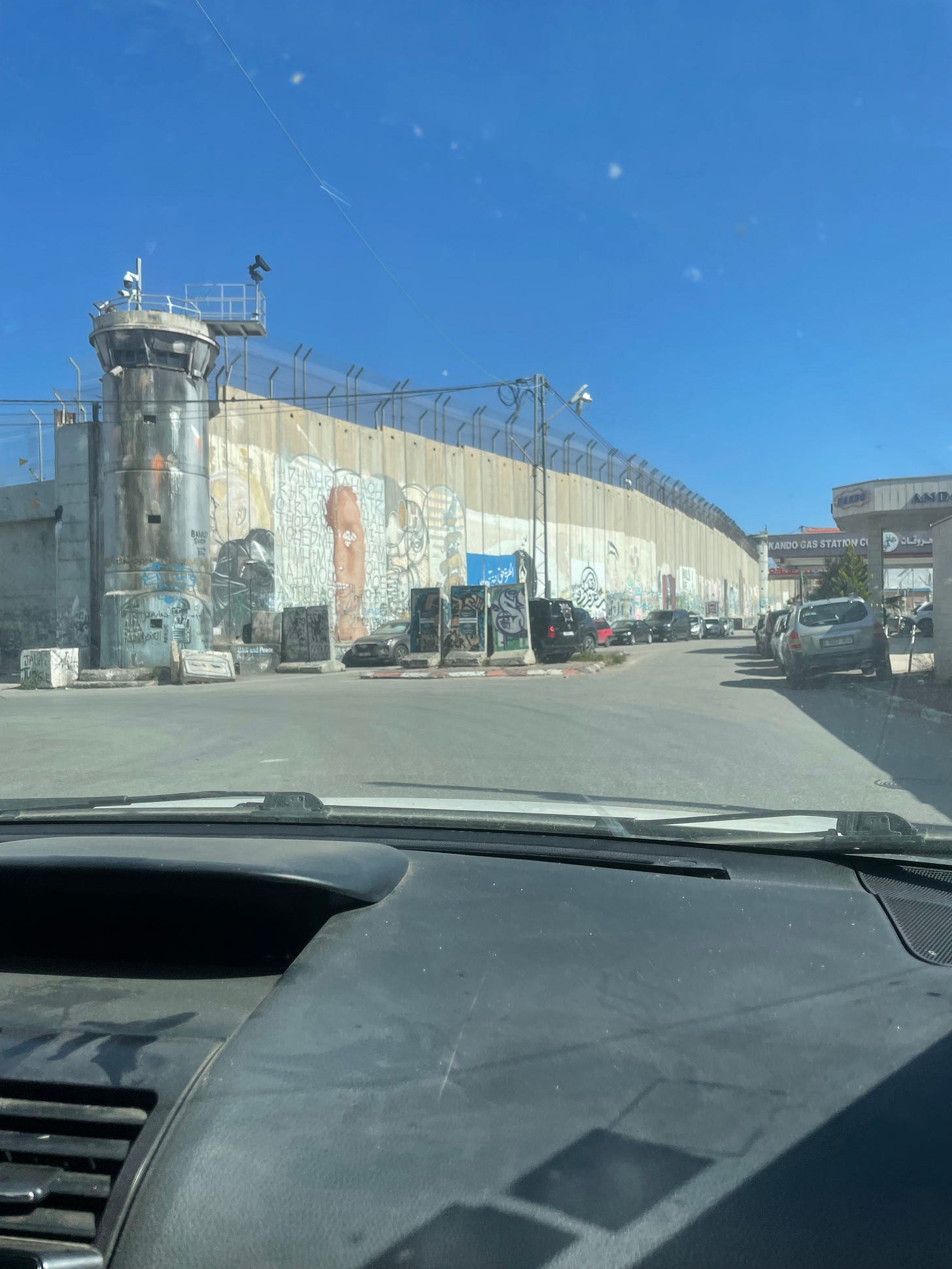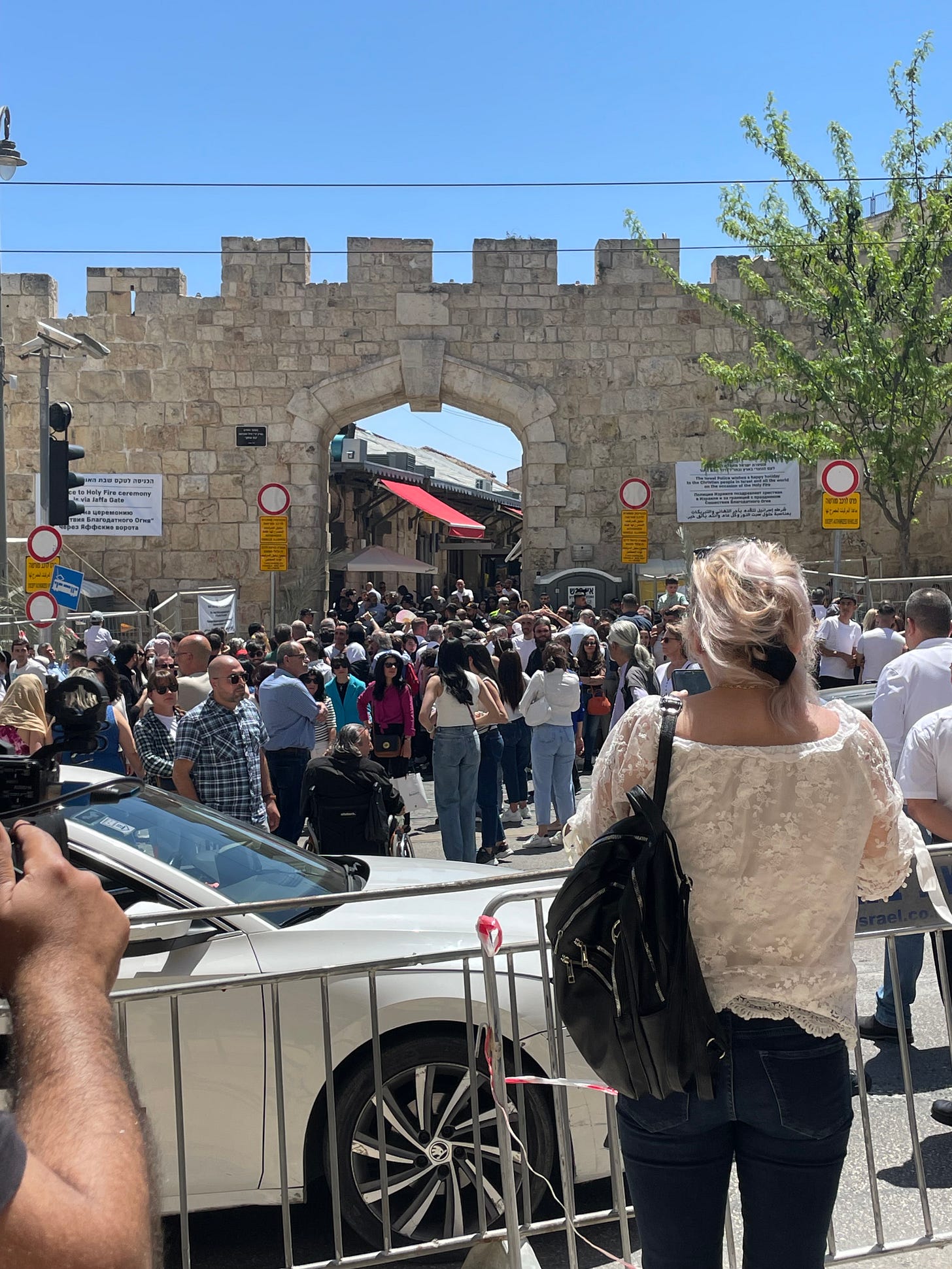I’m not sure if I’ve ever mentioned this, but I’ve spent every other weekend of the past three months in Bethlehem. Bethlehem is where my group goes for our days off. During these three months, I have developed a deep love for Bethlehem. Why? Well simply because it is an area A city. Area A cities in the West Bank are controlled exclusively by the Palestinian Authority. Unlike Area C, where Masafer Yatta is, Area A is often devoid of Israeli soldiers and settlers. Area A is almost always large cities in the West Bank. Of course, the presence of soldiers is quite apparent in cities such as Hebron, Jenin, and Tulkarm.
One of the things I love most about Bethlehem is the lack of soldiers, settlers, and general reminders of Israeli occupation. The only soldiers or Israeli flags I see are at the checkpoints in and out. Settlers of course are too afraid to enter a city filled with Arabs. Instead, Bethlehem is fortified with a giant wall around it that separates the Palestinians within from the rest of the country. In many parts of the city, the wall has been decorated in a plethora of graffiti.
My favourite thing about Bethlehem is that I feel safe there. Yes the PA is corrupt and there are spies everywhere, but there is no IDF. There are no illegal settlers. And the Palestinian flag flies everywhere. Because Bethlehem is an important place within Christianity, it has remained relatively safe under occupation. Only once was there a siege.
In Bethlehem, I enjoy a very classed experience. Though there are a myriad of refugees living in camps in Bethlehem, I don’t see them when I shop at the western grocery store or go out for sushi. Instead, I meet Palestinians who hire party planners for birthday parties, attend high schools with western curricula, and even women who smoke.
Despite the lack of violence, Bethlehem has also suffered greatly after what they call “Black October”. Since October, 2023, there has been almost no tourism in Bethlehem. Even when Christian tourists have come to Jerusalem, they assume it is too dangerous to travel across the “green line” and visit Jesus’ birthplace. Most stores are shuttered, not even finding it worthwhile to open most days.
Near the church of nativity, teenage boys follow me, trying to convince me to buy their magnets (I’ve bought a lot of magnets). Outside of the main square, i occasionally do shopping. Going into a clothing store to buy a sorely needed hoodie, I greeted the woman behind the counter before she tried to tell me that I was shopping in the men’s section. I assured her I was where I wanted to be while perusing the array of sweatshirts. Finally I decided on one.
Checking out, the woman asked me if I knew what the Arabic writing on my hoodie said. I replied I did not and in broken English, she tried to explain. I said “resistance?” back to her in Arabic and she nodded. Good enough for me. I handed her a bill to pay for the sweatshirt and she scrambled to find change. This seems to be a common problem in Bethlehem. With no tourism and little business that isn’t from locals, few places have change in their change drawers.
Vendors seems to always leave their shops for several minutes to go to their neighbours shops and find someone who can make change. This time, the woman came back and was still one shekel short. I assured her it was not a problem, but she insisted, rummaging around in her purse for a lone shekel.
I had the pleasure of being in Bethlehem for both the final night of Ramadan and Easter. At Iftar time during Ramadan, the market flooded with people celebrating, praying, and carrying huge platters of food around. Fifteen minutes later, the streets were empty as family and friends gathered in homes and restaurants to break their fast. On Easter this past weekend, I saw more tourists than I had ever seen in my three months here. Tour groups from Europe and Asia walked in groups and haggled with shop owners. There was a crowd at manger square.
Beyond just the tourists, I saw parades, musical celebrations, families in their nicest outfits, and cars honking for the lord. On Saturday, I went into Jerusalem for a few hours. I was originally planning to stop at a cafe in the Christian quarter of the old city for a cappuccino. But when i arrived at the New Gate, I again saw something I had never seen before. Massive gates and fences were set up around the perimeter of the entrance to the old city. The army and police were gathered in large numbers and seemed to be herding the Christians.
Deciding my caffeine fix was not worth it, I walked to the other side of the street to continue onwards. There, a few tourists and some Christian Palestinians were watching the scene unfold. Some news cameras were scattered amongst the crowd. I stopped and asked what was happening. Someone explained to me that the army was limiting the number of people allowed in to go to the Church of the Holy Sepulchre. I was surprised to see white, European tourists being mishandled by the army. Surely this was not good for business?
I watched as a group of people were allowed into the old city. The crowd flooded through before the army arbitrarily demanded (with force) that the line stop moving. I watched as two western, white women shrieked and held on to a third white woman who was stuck behind the soldier. The two women tried to pull her towards them, but the soldier pushed her back. Shrieks again erupted from the women. Surely this was not the sacred pilgrimage they were expecting.
I walked on to the Muslim quarter considering the scene I had just witnessed. On our way to Bethlehem, myself and my Jewish co-activists were trying to piece together the story of Easter. Though Jesus was born in Bethlehem, he rose again postmortem in Jerusalem. Indeed, the most sacred place to be during Easter is in the old city where Jesus was lain and then later resurrected (forgive me if this history isn’t correct).
Despite Jerusalem being the most sacred place to celebrate Easter, I decided the people in Bethlehem were having a much better holiday. Unlike their counterparts in Jerusalem, no one was pushing them around or insinuating their religion was inferior. Indeed, the people of Bethlehem were doing everything in their power to ensure that the tourists had a fabulous time and tell other congregants how safe it was.
Later I saw video of army violence outside the church of the holy sepulchre inside the old city of Jerusalem. Again I felt thankful for Bethlehem. They say Israel is the safest place for the Jews. That it exists to keep Jews safe and prevent harm against us. And yet, all the harm and violence I’ve experienced here is at the hands of the state. It is the Palestinians who I feel safe around. As one shopkeeper put it: “I am not a terrorist, I just want to sell you some things.”





